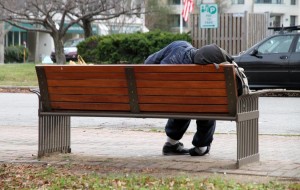 Arlington’s homeless population is down 27 percent over the past year and 64 percent since 2013.
Arlington’s homeless population is down 27 percent over the past year and 64 percent since 2013.
That’s according to figures released today by Arlington County, which conducted a count of homeless individuals on the streets and in shelters in January. The county credited two of its initiatives — 100 Homes and Zero: 2016 — with playing “key roles” in reducing homelessness by helping the homeless to secure stable housing.
“This is great news and further confirmation that our strategies are working,” County Board Chair Libby Garvey said in a statement. “By not only sheltering people from the elements, but helping them get back on their feet, we are saving lives and strengthening our community. It is the right thing to do and the smart thing to do.”
(The opening of Arlington’s new Homeless Services Center last year likely also helped.)
By Arlington’s count, there are 174 homeless people in Arlington — including 124 singles and 50 people in families.
“No families counted were without shelter,” the county noted.
Earlier this year the county announced that it had achieved its goal of “functional zero” veteran homelessness in 2015.
Arlington is launching two new initiatives intended to curb homelessness. One is the establishment of a Youth Task Force “to examine the nature and scope of youth homelessness.” The other is a “Risk Reduction Fund” that will allow landlords to loosen their rental eligibility requirements and thus take in formerly homeless tenants. The fund will reimburse landlords for “vacancy and damage costs” associated with such tenants.
The full county press release, after the jump.
For the third consecutive year, the number of persons who are homeless in Arlington has dropped, down 27 percent in January 2016 as compared to January 2015. The data comes from the community’s annual Point-in-Time Count. The total for the 2016 count was 174, down from 239 in 2015.
Overall, the number of homeless Arlingtonians counted has dropped 64 percent since 2013.
“This is great news and further confirmation that our strategies are working,” said County Board Chair Libby Garvey. “By not only sheltering people from the elements, but helping them get back on their feet, we are saving lives and strengthening our community. It is the right thing to do and the smart thing to do.”
The 2016 count was conducted January 27-28 as part of a regional effort, and includes people in shelters and on the streets.
Individuals
The number of homeless singles dropped 24 percent, from 164 in 2015 to 124 in 2016. This includes a 51 percent drop in the number of unsheltered homeless singles (from 39 in 2015 to 19 in 2016).
Two recent community efforts – the 100 Homes and Zero: 2016 campaigns – played key roles in reducing the number of homeless individuals.
“100 Homes and Zero: 2016 have given us a blueprint for success that we have incorporated into our ongoing work,” said Kathy Sibert, president and chief executive officer of A-SPAN, a local non-profit that helps homeless individuals. The two initiatives employed a deliberate approach – including using a by-name list of homeless individuals and holding monthly meetings to assess how they were progressing toward the goal of stable housing – that continues to work.
“Every person has unique circumstances,” said Sibert, “but the toolkit we’ve assembled is pretty strong and we’ve become adept at addressing challenges as they come.”
Families
The number of people counted in families considered homeless dropped 33 percent, from 75 in 2015 to 50 in 2016. No families counted were without shelter.
The reduction in the number of homeless families counted is, in part, a product of the County’s efforts to streamline services and prevent homelessness from occurring in the first place. Arlington implemented a Centralized Access System in 2015 – a single point of entry for individuals and families who have become homeless or are at risk of becoming homeless. The system quickly matches households with the interventions that will most effectively and efficiently prevent or end their homelessness and lead to stability.
“Shelters aren’t meant to be a first option,” said Cynthia Stevens, Housing Bureau chief for the Department of Human Services. “The prevention and diversion strategies we’ve employed are working well to keep households out of shelters. And when people do become homeless, we’re able to use Housing First strategies like rapid rehousing and permanent supportive housing to get them out of the shelters and quickly back into permanent housing, where it is much easier to address issues like employment and health. ”
New initiatives
The County’s Continuum of Care (CoC) — a network of interconnected programs and services to assist people who are homeless or at risk of becoming homeless — has established a Youth Task Force to examine the nature and scope of youth homelessness (both unaccompanied youth under 18 and transition age youth between 18 and 24). The CoC will be conducting a Youth Point-in-Time Count later in 2016.
Arlington also is launching a new partnership with community housing providers to reduce the risk to landlords who provide housing to households with significant housing barriers, such as poor credit, poor rental history or criminal background. Through this partnership, landlords will loosen eligibility criteria and gain access to a Risk Reduction Fund that is funded by the County’s Affordable Housing Investment Fund and the Arlington Community Foundation, to cover some vacancy and damage costs. CoC agencies will provide services, including rental assistance and case management, to the households who come into housing under the program.
Challenges
“These numbers are great, but don’t be mistaken – we still have work to do,” said Stevens. “Many low-income and formerly homeless Arlington households continue to struggle with the high cost of rental housing, even after transitioning to a housing subsidy program.”

